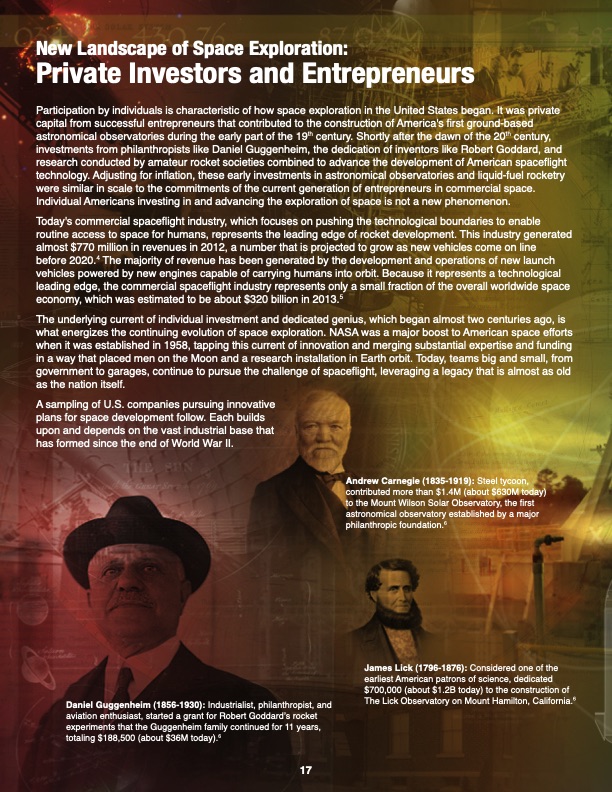
PDF Publication Title:
Text from PDF Page: 020
New Landscape of Space Exploration: Private Investors and Entrepreneurs Participation by individuals is characteristic of how space exploration in the United States began. It was private capital from successful entrepreneurs that contributed to the construction of America's first ground-based astronomical observatories during the early part of the 19th century. Shortly after the dawn of the 20th century, investments from philanthropists like Daniel Guggenheim, the dedication of inventors like Robert Goddard, and research conducted by amateur rocket societies combined to advance the development of American spaceflight technology. Adjusting for inflation, these early investments in astronomical observatories and liquid-fuel rocketry were similar in scale to the commitments of the current generation of entrepreneurs in commercial space. Individual Americans investing in and advancing the exploration of space is not a new phenomenon. Today's commercial spaceflight industry, which focuses on pushing the technological boundaries to enable routine access to space for humans, represents the leading edge of rocket development. This industry generated almost $770 million in revenues in 2012, a number that is projected to grow as new vehicles come on line before 2020.4 The majority of revenue has been generated by the development and operations of new launch vehicles powered by new engines capable of carrying humans into orbit. Because it represents a technological leading edge, the commercial spaceflight industry represents only a small fraction of the overall worldwide space economy, which was estimated to be about $320 billion in 2013.5 The underlying current of individual investment and dedicated genius, which began almost two centuries ago, is what energizes the continuing evolution of space exploration. NASA was a major boost to American space efforts when it was established in 1958, tapping this current of innovation and merging substantial expertise and funding in a way that placed men on the Moon and a research installation in Earth orbit. Today, teams big and small, from government to garages, continue to pursue the challenge of spaceflight, leveraging a legacy that is almost as old as the nation itself. A sampling of U.S. companies pursuing innovative plans for space development follow. Each builds upon and depends on the vast industrial base that has formed since the end of World War II. Daniel Guggenheim (1856-1930): Industrialist, philanthropist, and aviation enthusiast, started a grant for Robert Goddard’s rocket experiments that the Guggenheim family continued for 11 years, totaling $188,500 (about $36M today).6 James Lick (1796-1876): Considered one of the earliest American patrons of science, dedicated $700,000 (about $1.2B today) to the construction of The Lick Observatory on Mount Hamilton, California.6 17 Andrew Carnegie (1835-1919): Steel tycoon, contributed more than $1.4M (about $630M today) to the Mount Wilson Solar Observatory, the first astronomical observatory established by a major philanthropic foundation.6PDF Image | Emerging Space

PDF Search Title:
Emerging SpaceOriginal File Name Searched:
Emerging_Space_Report.pdfDIY PDF Search: Google It | Yahoo | Bing
NFT (Non Fungible Token): Buy our tech, design, development or system NFT and become part of our tech NFT network... More Info
IT XR Project Redstone NFT Available for Sale: NFT for high tech turbine design with one part 3D printed counter-rotating energy turbine. Be part of the future with this NFT. Can be bought and sold but only one design NFT exists. Royalties go to the developer (Infinity) to keep enhancing design and applications... More Info
Infinity Turbine IT XR Project Redstone Design: NFT for sale... NFT for high tech turbine design with one part 3D printed counter-rotating energy turbine. Includes all rights to this turbine design, including license for Fluid Handling Block I and II for the turbine assembly and housing. The NFT includes the blueprints (cad/cam), revenue streams, and all future development of the IT XR Project Redstone... More Info
Infinity Turbine ROT Radial Outflow Turbine 24 Design and Worldwide Rights: NFT for sale... NFT for the ROT 24 energy turbine. Be part of the future with this NFT. This design can be bought and sold but only one design NFT exists. You may manufacture the unit, or get the revenues from its sale from Infinity Turbine. Royalties go to the developer (Infinity) to keep enhancing design and applications... More Info
Infinity Supercritical CO2 10 Liter Extractor Design and Worldwide Rights: The Infinity Supercritical 10L CO2 extractor is for botanical oil extraction, which is rich in terpenes and can produce shelf ready full spectrum oil. With over 5 years of development, this industry leader mature extractor machine has been sold since 2015 and is part of many profitable businesses. The process can also be used for electrowinning, e-waste recycling, and lithium battery recycling, gold mining electronic wastes, precious metals. CO2 can also be used in a reverse fuel cell with nafion to make a gas-to-liquids fuel, such as methanol, ethanol and butanol or ethylene. Supercritical CO2 has also been used for treating nafion to make it more effective catalyst. This NFT is for the purchase of worldwide rights which includes the design. More Info
NFT (Non Fungible Token): Buy our tech, design, development or system NFT and become part of our tech NFT network... More Info
Infinity Turbine Products: Special for this month, any plans are $10,000 for complete Cad/Cam blueprints. License is for one build. Try before you buy a production license. May pay by Bitcoin or other Crypto. Products Page... More Info
| CONTACT TEL: 608-238-6001 Email: greg@infinityturbine.com | RSS | AMP |